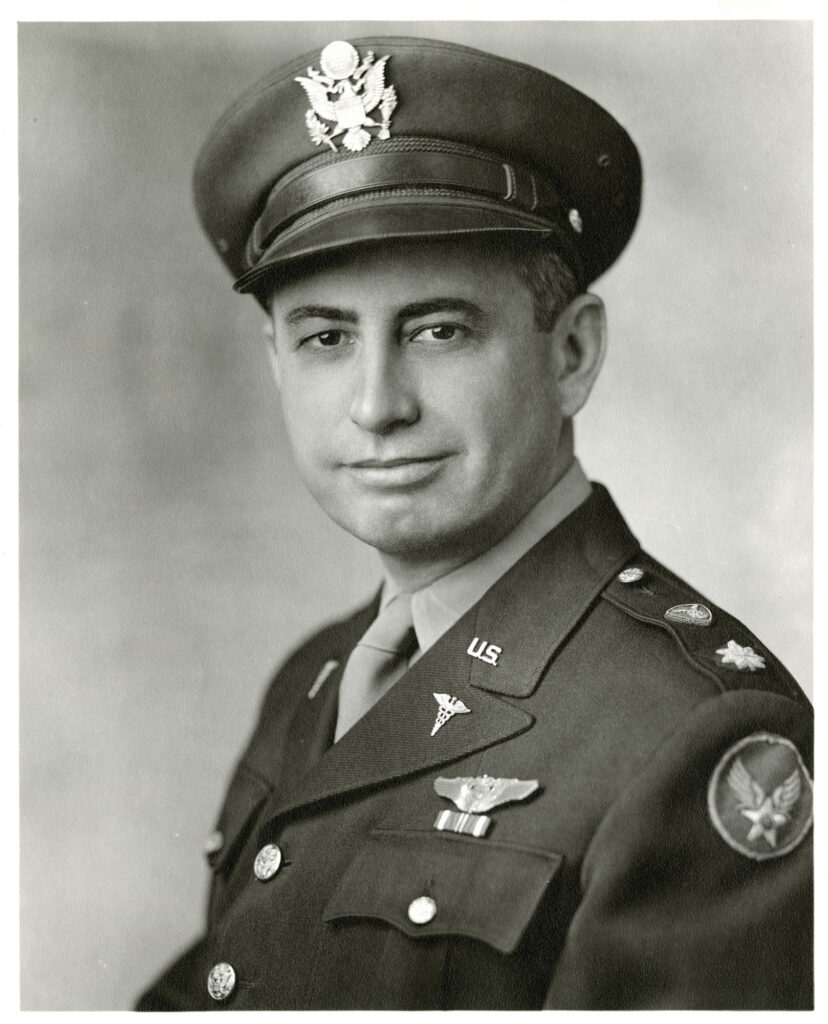Experimented on the problems of high altitude escape and parachuting.
William Randolph “Randy” Lovelace II, a native New Mexican, was born in 1907. He graduated from Harvard Medical School in 1934. After residencies at Bellevue Hospital in New York and the Mayo Clinic in Rochester, Minnesota, he traveled to Europe during the 1930s for further medical studies. He returned to the United States to volunteer as a Flight Surgeon and First Lieutenant in the Army Medical Corps Reserve. Interested in problems faced by pilots flying higher and faster, in 1938, he transferred to the Aeromedical Field Laboratory at Wright Field in Dayton, Ohio to develop a high-altitude oxygen mask. Dr. Lovelace and his staff of researchers invented a unique oxygen mask that he personally tested in flights up to 15,000 feet. The first public announcement of this breakthrough was made in September of 1938.
On active duty with the Army Air Corps as a colonel during World War II, Lovelace used himself as a test subject in further experiments on the problems of high-altitude escape and parachuting. On June 24, 1943, he made his first parachute jump, bailing out of an aircraft 40,200 feet above Washington State. Although he was knocked unconscious by the opening shock of the parachute at the high altitude, and his hand was frostbitten when one of his gloves was torn away, valuable data was gained from his ordeal and he was awarded the Distinguished Flying Cross for the experiment. He returned to private practice after the war, and in 1947, founded the Lovelace Clinic in Albuquerque, New Mexico.
Dr. Lovelace continued to conduct research, helping to improve aviation and aerospace medicine, and in 1958, NASA, the newly created space agency, asked him to be the chairman of its Special Advisory Committee on Life Sciences. The next year, a group of Lovelace Clinic aviation medicine experts under Dr. Lovelace’s direction put 31 of the original astronaut candidates through a week of medical exams, in Albuquerque. On April 9, 1959, those chosen as the best responders to the test were introduced to the world as The Mercury Seven, America’s initial astronauts. Lovelace was present at the ceremony and described the rigorous testing undergone by the astronauts to the press.
Dr. Lovelace then helped NASA draw up a profile of the perfect astronaut, based on years of medical testing experience of pilots. These guidelines were used to help select astronauts for the Gemini and Apollo programs. Lovelace believed that these guidelines showed that women were just as capable of space travel as men, and in 1960, he helped chose 25 female astronaut candidates, some of which were selected as the “Mercury Thirteen” the next year. The program was abruptly canceled, however, in September 1961.
In 1964, Lovelace was appointed NASA’s Director of Space Medicine. A year later, while Dr. Lovelace and his wife were flying in a private plane near Aspen, Colorado, their pilot became disoriented and flew into a mountainside, killing all aboard.
Dr. “Randy” Lovelace is commemorated by the Lovelace Crater on the moon and the William Randolph Lovelace II Award, given by the American Astronomical Society every year in recognition of exceptional contributions to space science and technology.

